
August, 2007
8/1-2: With only a couple of days in the middle of this week to have a quickie trip, when Sue's morning business meeting dragged on a couple of hours past our planned departure time, my temper went off the scale and threatened an explosion that could have ruined the shorter period we had left to enjoy the fishing experience.
But after 60 or so road miles, I had an attitude adjustment and the drive to our favorite stream was less difficult than it might have been. Given our late start we didn't arrive at our starting point on the river until almost 2:30 in the afternoon. A large thunderstorm churning overhead made for some more delay in getting on the water, so I suspect we didn't even make our first cast until close to 3:00.
Statewide reports have the river fishing poorly in the middle of the day which caused our expectation levels to be quite modest compared to the last trip here in July. Happily all our fears for poor success ended once the strikes began quite quickly in the "trough" hole where we elected to start.
Sue had rigged a bit differently from myself today and for a while my setup probably worked a bit better, but as the day lengthened into early evening, her dry was more effective.
Given the lower water levels (though not by much), I assumed we'd have more luck nearer the bottom so I started with a surface rubber leg WRS trailed a couple feet by a black copper john, and then another eighteen inches by a newly created sparkle wing #18 RS-2. The last named fly was remarkably successful this afternoon. It took the first five fish I hooked (but didn't actually land), and was probably the most productive fly overall for the day.

Sue used a rubber leg WRS to start with, but shortly changed to a standard WRS and had much quicker luck in getting fish to come to the surface as that fly more closely imitates the local caddis population, several of which seemed to be in the air most of the time.
Let's be direct. The fishing was absolutely wonderful again. I just can't believe how good it is up here. If there's a better section of publicly accessible water in the states, I can't imagine where it would be.
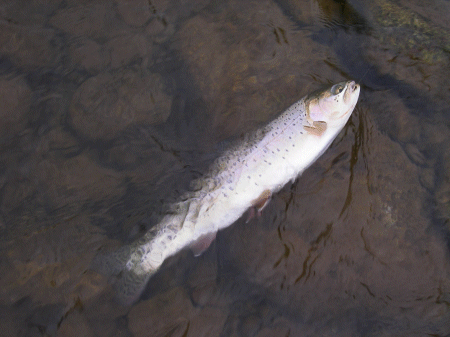
A nice Colorado Cutthroat. Probably released more mixed "breeds" than pure strains of this fish.
The only problem I had this afternoon was actually getting fish close enough to actually pop the fly out a mouth with the forceps.
Would guess I "long released" 9 out of 10 fish for the first hour or two. That's actually a good thing, but darn it, I really do like to get up close and personal with a nice fish from time to time.
Sue had a lot more releases than did I. Don't really know what caused my issues today. Maybe softer mouths later in the summer? Or more likely too much pressure in fast water? No explanation for it.
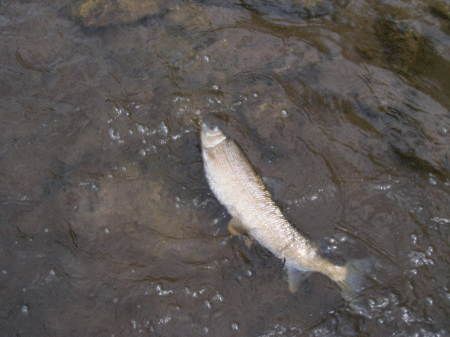
The ever present whitefish are sometimes fun - sometimes not - especially when they break tippet while trying to release them.
Anyway we both shared very similar sized fish throughout the three hours we spent wading this mile long stretch of river.
Rainbows mostly, but a couple of nice cuts, cutbows, and scattered browns along with the ever present whitefish made up the catch today. Sizes were all over the place. It's good to see young of the class included in the mix as those are our fish of the future.
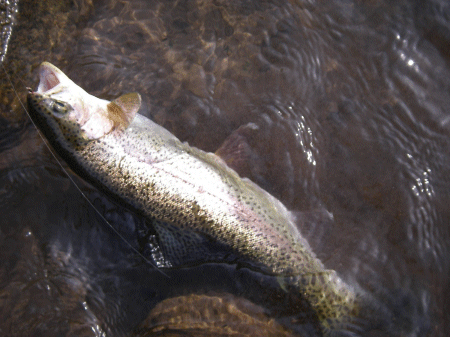
Until we hit the upper part of the wade, I'd guess most fish in a fourteen to sixteen inch range, a few larger - mostly hooked and lost - and a few smaller.
All seemed to be in excellent shape and don't show signs of the sore mouths that we see on many tailwaters.
Until curing my early release issue, none of the big fish that were hooked got close enough to be "shot". Finally just before leaving the water, I was able to pop the hooks out of a three pound brown and four pound buck rainbow respectively.

A nice brown. We're seeing more of them further upstream than in the past. Don't know if that's positive or not.
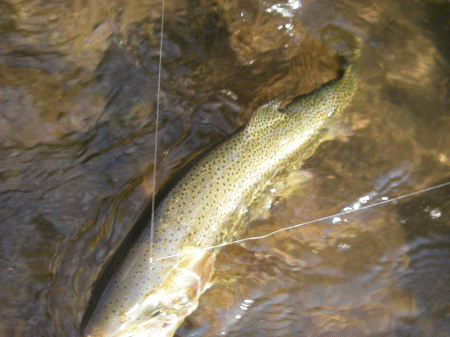
Large male rainbow that took the surface WRS just before we left the river this evening.
A little after six in the evening we drove to our regular campsite on the upper North Fork. Had a nice happy hour, salad for dinner, and I did a short bit of casting before settling in the top bunk of the van for the night.
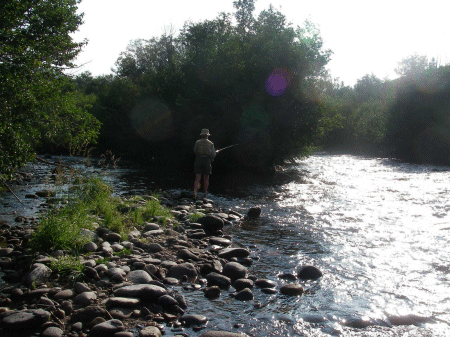
Up the next morning we headed further up into Forest Service land to try the smaller upstream areas for some of the many little cutthroats that usually live up there.
First spot gave up none of those nice fish and only a couple of smaller rainbows so we tried it again a bit further up towards the lakes with no further success.
Did a turnaround and headed back downstream to some "catch and eat" pocket water that can sometimes be productive despite being in that unfortunate category of stream access. Sue opted to sit this one out while working on her last crossword puzzle so I did the quarter mile wade here by myself.
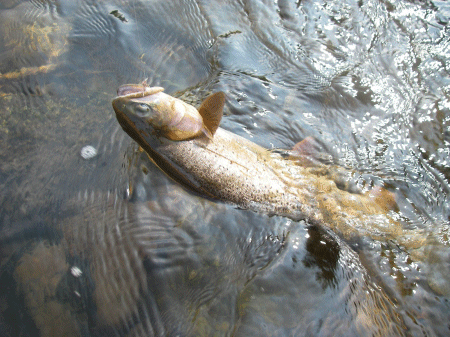
It turned out to be not bad at all - especially with the chance to hook and release a wonderful eighteen inch Colorado cut shown here.
Was the only photo of a large cut we were able to get on the trip.
Thought about repeating our yesterday afternoon wade, but drove to town instead and tried fishing near a park where I'd usually catch a handful or so of browns. Today it was a bust. Couple of strikes and nothing more.
Nonetheless it was another great trip to a really delightful stream. I may try to finally fish Gore Creek this weekend before we head down to the Conejos for our first attempt at that far south Colorado river later next week.
8/8-10: BOOM OR BUST! That pretty much characterizes our fishing life this summer. Probably more than Sue, I was really excited about our trip on Wednesday to the far southern part of our state. Neither of us had ever visited there, and the write ups coming from guides in the area over the internet were very intriguing.
Dare we say TIMING IS EVERYTHING! Unfortunately ours - dare I suggest in the vernacular - sucked this week. Despite checking stream flows on the relevant rivers and creeks, I did not pick up on the fact that the previous several day's major thunderstorms had either blown out or had raised the water levels where we planned to fish to points that made the probability of success more or less impossible.
But with four to five days to spare we drove down the Arkansas to Poncha Springs and then further south through Alamosa and Antonito with the intent of investigating the Conejos River and its major tributaries for that entire period of time.
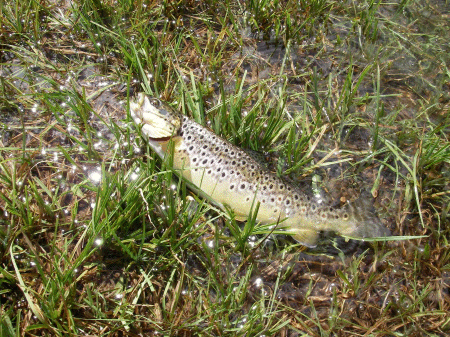
On first sight of that river, our concerns about flow levels were confirmed. The stream was swollen with mud and debris and ran at least a good foot or two higher than the bankside grasses would indicate was seasonally normal.
However, since we were already a couple hundred miles from home, we continued on up the river, hoping against hope, that the good weather we were enjoying at the moment would cause the stream to magically drop quickly and give us our anticipated good fishing experience.
It didn't happen.
We made a number of walking forays down to the river on our drive up towards its headwaters and found no help in the sense of moderating flows from the good weather we were experiencing on this day.
Here are a few general observations I'd make about the Conejos specifically and this part of the state in general. Keep in mind that these comments are obviously flavored by the somewhat negative time we had down here, but hopefully there's at least a modest amount of objectivity in the notes.
1. Internet sites and local river outfitters suggest many miles of public access on the Conejos. We found that not to be true. The stream is very heavily developed and partitioned by private holdings. While there is adequate access for us and the rest of the masses of people wanting to access the stream, it's not the amount of space purported to be available.
2. Even had we carefully fished all the public access points, the river and its tributaries need to be hiked substantial distances to find quality water.
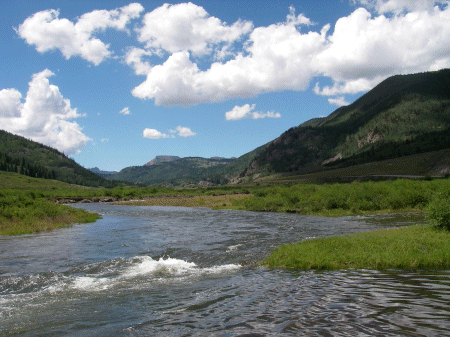
3. The tailwater below Platoro Reservoir was running high and was difficult to fish, but with the five to seven c.f.s flows in the winter months, it's unlikely that many, if any, quality fish exist there.
4. The trailhead at the junction of the south and north forks of this river may be one of the best points to access relatively untouched water on those same forks.
5. Platoro Reservoir, despite being praised by local guide services, is basically a butt ugly body of water and did not appear to be a quality lake. Obviously this observation could be totally off base, but only one boat was visible on that water when we passed by the lake on our way to the upper river.
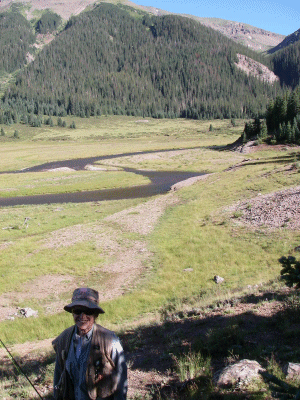
6. Fishing the upper Conejos (above the reservoir) with high water flows is almost impossible. Getting to the three forks that form the main stream - again above the lake - requires a decent amount of hiking.
Pictured here is the inlet to Platoro. This gravely section was fishable, though not productive. In a deeper part of this generally shallow stream, I hooked something truly huge, but with a couple of shakes of its head, the barbless streamer came loose.
It was, however, a really massive fish, based on how it felt for the few seconds it was on.
7. Given our experience, we'll likely never come back here. It's unfortunate. The overall appearance of the river really is quite attractive and the scenery in the area itself is probably worth the trip.
8. If the reader has a topo map of Colorado, following Forest Road 250 all the way over the pass above Platoro and down to the upper part of the Alamosa River is not worthwhile doing. This latter named river is so impacted by heavy metals leaching into the stream from natural rock formations and probably still from the notorious Summitville Mine site, that the Alamosa River appears to be completely unfishable.
It too was running high, murky, and orange colored from the same rains that ruined the Conejos for us. Local outfitters declare this river to hold brooks, browns, and rainbows and that it is lightly fished. While we'd guess it truly is lightly fished, the likelihood that those named species are present here in a quantity worth pursuing is highly questionable.
9. The back roads serving this area are not particularly steep but definitely are slow going. FR 250 which is the main access road through the whole system is heavily wash boarded and potholed and allows speeds ranging from 20-30 m.p.h. at most. Directional signage is either missing or so well disguised that finding off beat areas is quite tough. We'd hoped to visit La Jara Reservoir and the upper part of that named creek but simply could not locate the canyon road leading there.
That's about it for the first part of our trip. Sounds miserable but really wasn't all that bad due to the wonderful mountain scenery. We did pick up a trout here and there, and as we moved further north after leaving this basin, fishing conditions improved significantly.
After spending one night in this part of the state, we opted to leave and continue back towards home going through Monte Vista, Creede, and Lake City back towards Gunnison. Again, unhappily the recent storms had also impacted the Rio Grande on our way so despite making a few casts into that murk, no strikes came to our streamers and we were disappointed again.
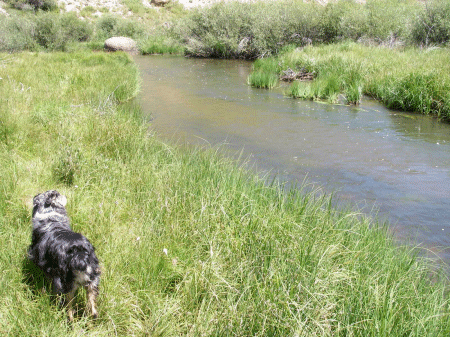
On the high mountain pass above Lake City we tried both the North and South Forks of Clear Creek, again with no success due to high and roily conditions in these pretty little streams.
Passed through Lake City and made our way down to the lowest section of available public water on the Lake Fork of the Gunnison and here actually found a bit better fishing.
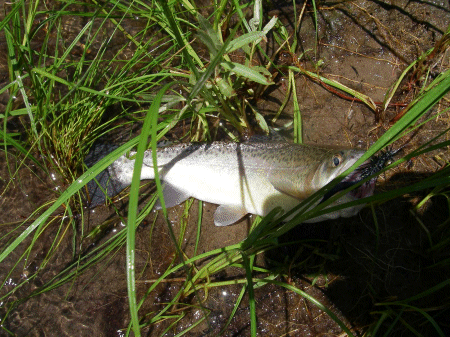
Although the water was still off color and high in the steep canyon, strikes came fairly regularly to a black wooly bugger.
Had flows been even halfway normal, I suspect we could have spent a good day and a half on this water and we would have done well here.
Gassed up in Gunnison and continued through Almont to the Roaring Judy section of the East River.
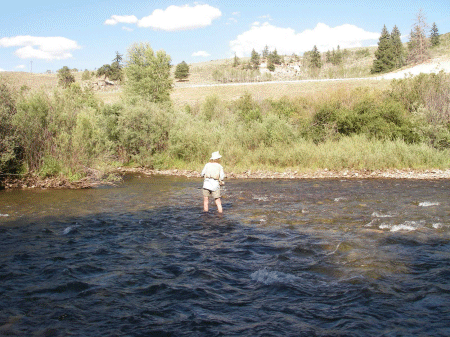
Although mosquitoes were a problem, finally, we found a river that was not storm impacted and we enjoyed some decent success on the smaller browns that populate the water.
No sign of any kokanee yet running up from Blue Mesa.
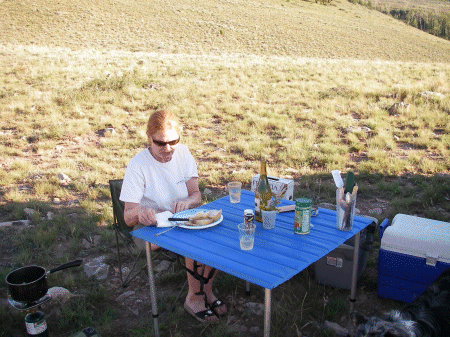
Camped that night on our wonderful spot high above the East and Taylor River valleys at the Almont Triangle.
Next morning we plied the frigid waters of the Taylor from Almont to the reservoir of the same name. Very difficult fishing.
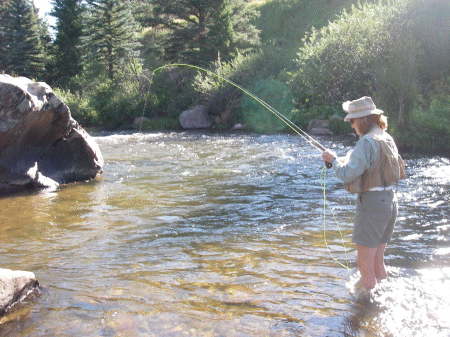
Sue landed the only rainbow of this section. We really don't understand this river. It's tough for us to find good holding water.
Seems to be a case of driving to a pull off, fishing for a few minutes and then moving on to the next spot. There are just not prolonged stretches of easily wadable stream.
Had we unlimited time to spend stopping at each and every parking spot, we'd probably eventually figure out the river.
We didn't bother with the tailwater below the dam. Too many people and too much work for too little reward. I like testing these fish from time to time but prefer to do it later in the day when most of the crowds have headed back home.
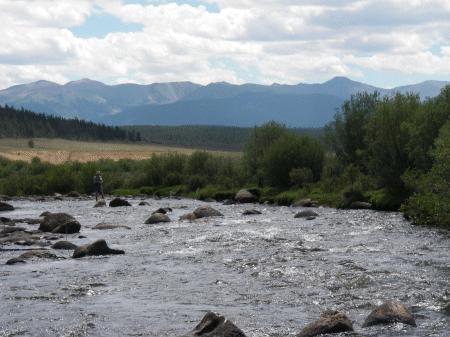
Above the lake it was another matter. We historically have had a good time on the inlet stream, and today was no exception.
Despite the presence of way too many off road bikes and vehicles, we found a half mile of nice pocket water to throw our flies. The little browns up here are lots of fun and very accommodating to virtually anything tossed their way.
Best of all, being fairly swift water, the fish are opportunistic as opposed to normal selective brown trout behavior, so despite sizes being mostly under a foot in length, this turned out to be the best fishing of the three day trip.
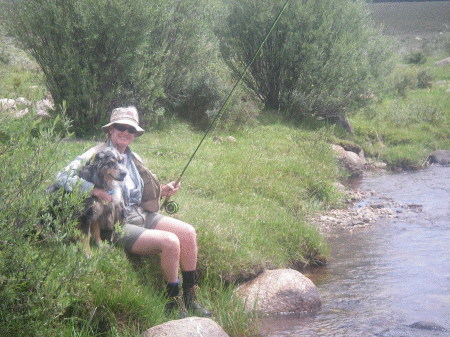
Though we'd planned a bit more casting on the Arkansas on the way back through Leadville, we were both relatively sated at this point and closed the trip out without more wading.
No further plans for the coming week or two - maybe we'll finally try our local waters - if the crowds subside..
8/12: It's been so long since I fished our lovely little home water of Gore Creek that I can not remember when last that happened. We've been so caught up in taking multiple day trips this summer to faraway places we've almost forgotten our "roots".
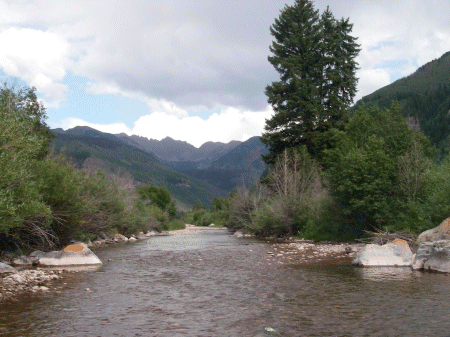 That all changed this afternoon when I bungeed my full flex eight footer to
the bike and peddled out to the golf course stretch of this stream. With
the passing of last week's thunderstorms the creek has finally relaxed to
regular late summer levels and actually was much warmer to wade than I'd
recalled.
That all changed this afternoon when I bungeed my full flex eight footer to
the bike and peddled out to the golf course stretch of this stream. With
the passing of last week's thunderstorms the creek has finally relaxed to
regular late summer levels and actually was much warmer to wade than I'd
recalled.
The golf course area is more lightly fished than stretches in town and through the gold medal part in West Vail, mostly due to very limited parking pull offs.
In fact should the casual fisherman decide to use one of those few pull offs along the creek by the course, the likelihood of his getting a ticket from the local Gestapo is very great.
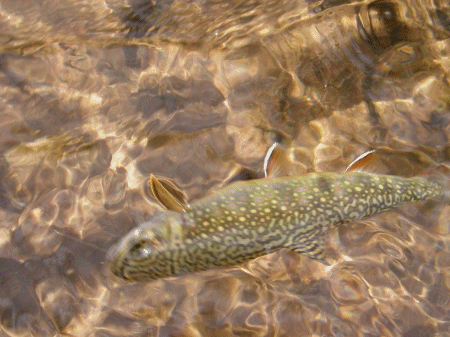
Fish sizes out in these hinterlands are certainly smaller than where the creek flows swifter and faster, but they're fun anyway - and it's always nice to not have any competition for the water.
I started casting down behind Ford Park and worked my way upstream for almost a mile. Used an up and down rig of a #18 tan/gray WRS on the surface, it was trailed roughly eighteen inches by one of the "new" sparkle wing semblances.
Both flies took fish today, probably more coming to the floater but enough to the nymph that the latter can finally be labeled a keeper.

Most of the quieter flats and all of the deeper riffled areas held a fish or two, sometimes more. Missed a lot of strikes which seems to be a continuing failing of mine, but enough hooked up to make it a fun session.
Released only rainbows and some smaller brooks today although it's possible to "grand slam" the stream from time to time with cuts and browns in addition to the two species I caught today.
Sizes were not great. A couple of the rainbows were in at roughly a foot long and all of the brookies were shorter. Nevertheless it was a fun couple of hours and certainly will be worth repeating before the summer is over.
8/16: Sue headed to Denver this afternoon to visit her folks and also get three new paintings framed, so the dog and I sneaked out of the condo and drove to State Bridge for some casting on the Colorado. Since we'd not had devastating thunderstorms for the past three days, I was hopeful that the river would be clear enough - and also low enough to do our long upstream wade along some cliffs and not have to hike way up a steep hill to get to the better water.
As luck would have it - again (see the Conejos above) - neither decent condition existed. Apparently there are heavy releases going on from Green Mountain Reservoir, and in all honesty, the river was much more colored than we'd hoped would be the case. That coloration came from a truly unexpected source.
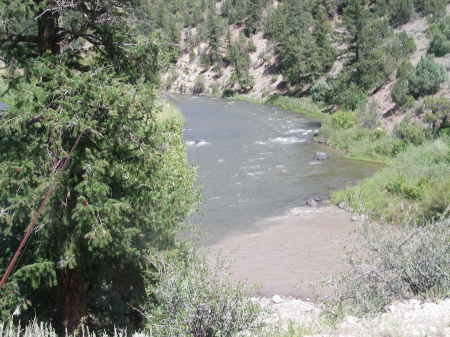
Looking upstream from the banks of the river by the bridge, it became apparent that of all things, the Piney was discoloring the Colorado. Have never witnessed that before ever and hope to never have that happen again.
There's no good reason for the Piney to be off color - and it was truly muddy as can be seen where it enters the main river here in this photo.
Since the Piney was not flowing at a higher rate than would be normal this time of the summer, my suspicion is that someone upstream - probably on the Lindholm property - was doing some streambed improvement work.
Anyway it was a messy situation and left me very discouraged. Nevertheless rigged up, hiked up to the mouth of the Piney, forded that stream, and then began some listless casting to some narrow shoreside holding areas along a fast moving riffle.
Amazingly the strikes started coming almost immediately.
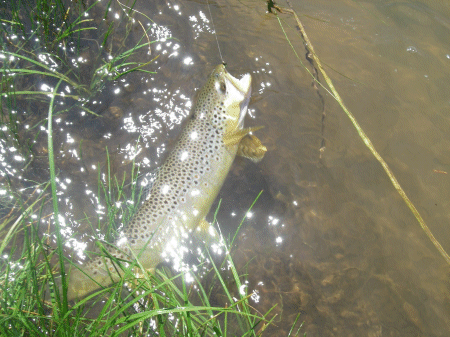
The first brown to hand was a nice fat fourteen incher and the best fish of the afternoon. He took the leading nymph which was a #16 lime colored copper john.
In the next hundred yards of water I'd guess having a good dozen more strikes and releasing another handful of somewhat smaller fish - again all browns.
They took either the copper john or a #18 sparkle winged semblance fly. Actually don't know how they even saw the latter in the dark water, but they must have much better vision than I do.
Due to the higher flows (a good foot over the streamside grasses) we opted out of making the trip much further upstream - which was a shame as it appeared the fishing was going to be very productive this day.
A few more casts below where the Piney was dumping mud into the main river were made without any other contact - but the afternoon was certainly not the complete loss it could have been.
8/20-22: This week's expedition probably better comes under the heading of casual outing. We knew where we were headed but didn't worry about getting anywhere in a hurry. After breakfast Monday morning we loaded up the Element and took off down I-70 towards Glenwood Springs and there continued up the Roaring Fork to Carbondale. The Fork was murky again this morning as has been the case with too many of the streams we've visited in the past month or two.
Unfortunately we knew that the discoloration was inevitably caused by the Crystal which was our planned first place to start casting. We've just had no luck timing our trips to this river this season. Sure enough it was cloudy - but at least seemed to be marginally fishable. Our first stop just below the entry into the USFS area was completely worthless.
Sue took one look at the flow and went back to her crossword puzzle. Good plan as it turned out. I waded the river and fished up and down for a quarter mile or so with no releases and only two strikes to show for the work.
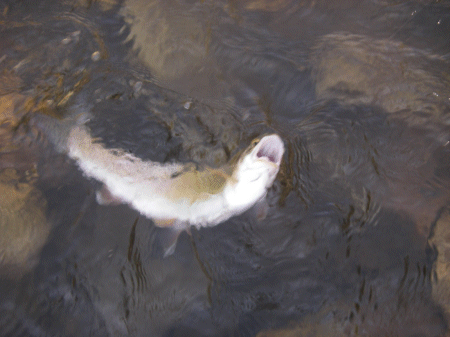
It got a little bit better up in Redstone where the shallower riffle water at least allowed the trout to catch a glimpse of our flies.
Sue released three smallish rainbows and I played a couple here, but the results were far below our usual ones.
Gave up on any more of this river, drove over McClure Pass and down to the confluence of Anthracite and the North Fork of the Gunnison. More cloudy water met us there. The releases from the base of Paonia Reservoir were so bad the combined stream - like the Crystal - was marginally fishable but really didn't look pleasant at all.
It wasn't. Sue came up empty handed and I released only a single ten inch rainbow. The trip was not looking good. We gave up for the day.
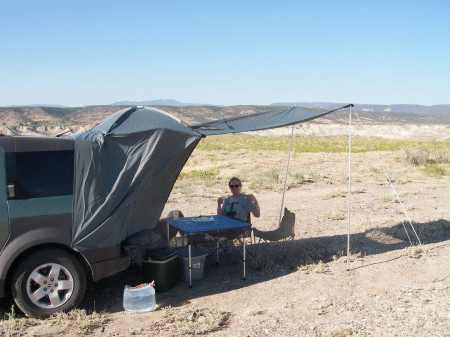
Drove down the North Fork, through Hotchkiss, past the turnoff to Pleasure Park and eased our way up a good dirt road to our favorite camping spot atop a mesa overlooking the main stem of the Gunnison.
With temperatures in the high 90's, we took advantage of our new cabana cover
which can be extended further out with some poles to create an awning for the
table. 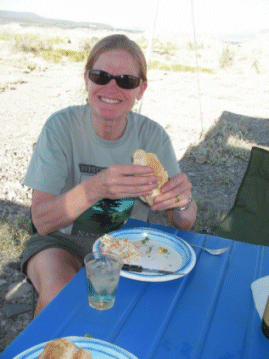
It worked great and we enjoyed some decent chardonnay along with a special treat - a lobster roll. Wonderful!
The dog had a good time howling at the half moon at night, and I suspect that noise kept the local coyotes further away from the car than is usually the case.
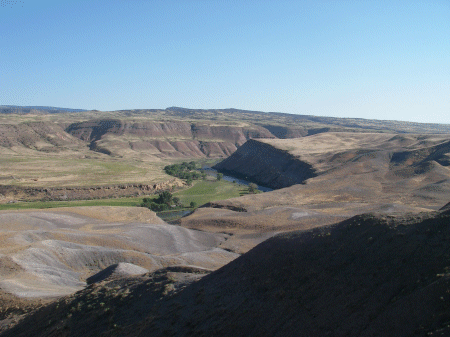
Next morning we drove the few miles back to Hotchkiss, had a good sized breakfast Panini at the local coffee house, then motored back to Pleasure Park and rigged up for the long hike up the Gunnison.
This river's releases from the upstream dams have been increased to over 900 cubes. While I don't know if the higher flows helped the fishing any, they sure did improve the quality of the water for the local inhabitants.
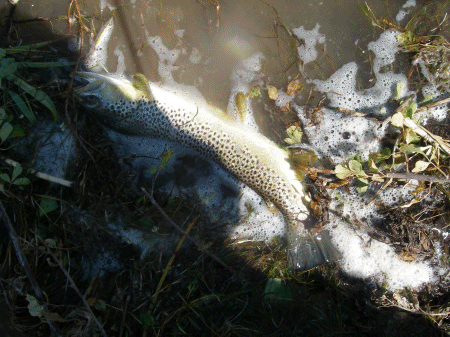
At that rate, fish could move closer to undercut banks and also enjoy much more protection midstream from airborne predators - obviously as well as humans.
After hiking a mile or so, I started casting while Sue re-rigged and fairly quickly played a couple of sub twelve inch browns and missed a strike by a much larger fish.
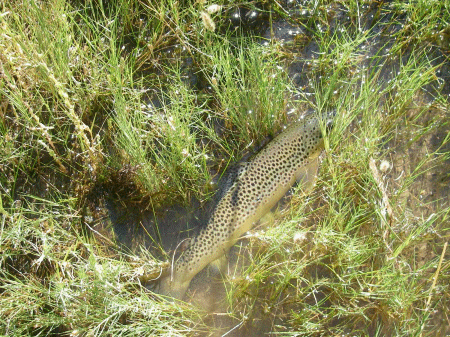
The action wasn't great over the next mile we walked, but pretty soon, I started getting lots of strikes on the swing which was quite unusual.
Big green hoppers are everywhere along the banks, but for some reason even when one was on the water, the fish seemed reluctant to swallow it. I suspect people have been fishing hopper imitations so much here that the always wily browns are even more cautious.
OK, so the way we were rigged was with a #16 white rubber leg WRS on the surface and a trailing prince or copper john. We'd get a few reluctant rises to the dry from time to time, but the fish really wanted something under the surface. Pulling the WRS under water and twitching it back to us seemed to work much better. Once in a while the fish would actually hit that fly (think swimming hopper?), but most of the time they'd take the nymph trailer. It was fascinating. Don't think we'd ever experienced consistent action using this kind of tactic.
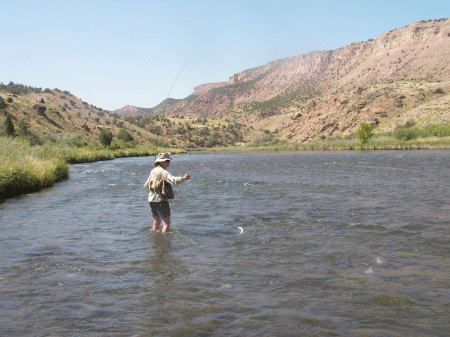
This setup continued to work well all the way up river, and when we finally were able to wade some shallower riffle water, the standard casting upstream and drifting straight down worked fine too.
All the fish we released today were browns, the best being around sixteen inches. Very nice results here.
On the way back to the car I shifted to a green rubber legged wooly bugger using the same small prince as a trailer and had much more continued success using that cross stream twitched retrieve. As much as I'd like to say that bugger looked like the local hoppers, from the fish's perspective it clearly did not, as they took only the trailing nymph. A couple of the fish (not landed) were much larger than those noted above. Two snapped the 5# test flouro tippet, something that I haven't had happen in recent memory.
Despite the oppressive late afternoon heat we wanted to try a bit more fishing so went back up highway 133 towards McClure Pass and turned up Anthracite Creek driving to the Erickson Springs campground. Anthracite is a pretty little sharply dropping high mountain stream that suffers periodically from devastating mudslides and discoloration but which today was clear as a bell.
There aren't lots of fish in this part of the river - the Dark Canyon section is much better - but it's easy wading at the low late summer flows and fish do sit in tiny pockets behind the rocks. We didn't catch many, nor any larger than twelve inch rainbows, but it was delightful casting to small holding zones and trying to keep the fly drifting dead for a few microseconds.
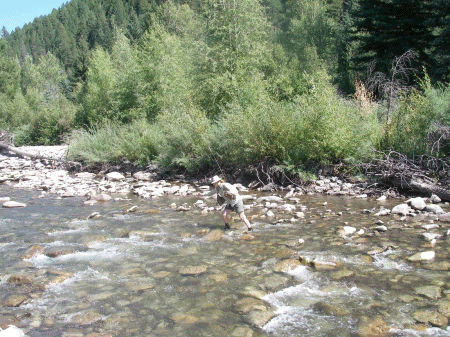
More or less everywhere a fish should have been, there was one. Sue also released a little whitefish as a nice change from nothing but rainbows.
On the way back down Anthracite we did the turnoff up Coal Creek which is Anthracite's major tributary and in fact probably has almost the same level of flows. It is, however, for whatever reason, no match for the other stream.
I had but one strike from a very wary trout of some type while fishing at least four hundred yards of water that on the Anthracite would have given up at least a dozen strikes. Don't know why this is the case, but it just doesn't seem to have the same kind of fishy populations.
That was more or less it for the trip. We spent the night on our wonderful spot above the Crystal looking directly at the Raggeds. Today we thought about refishing the Crystal on the way back downhill, but it was still cloudy - and besides it's too cold to wet wade at 7:30 in the morning.
So we drove to Carbondale, had a filling breakfast at our favorite spot there and got back to Vail before noon.
Last Logbook Entry � for previous days
8/30: Probably our last trip of this month and also suspect it's the last before we head to Wyoming and Montana around the 6th of September. Best of all, it turned out GREAT!
Being a short day outing, we drove over Ute Pass, down to Hwy. 40 and then to a moderately fished SWA below Barr Canyon on the Colorado.
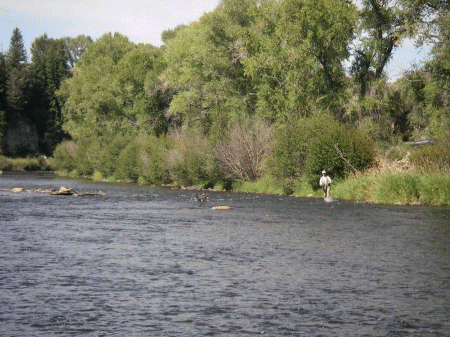 We did a relatively
lengthy downstream hike along the bank to start casting in a fairly deep
(maybe three feet max) run for this stream at this time of the year.
We did a relatively
lengthy downstream hike along the bank to start casting in a fairly deep
(maybe three feet max) run for this stream at this time of the year.
No hatches beyond the morning trico dun emergence were visible the three hours we were on the water. Nevertheless fish periodically sipped something on the surface or what was emerging most of the time we were there on the water. We never figured out what those insects were.
For the first couple hundred yards we had no success at all. Both of us were rigged with a surface PMD trailed by - Sue's unweighted RS-2 - and I with a lead weighted sparkle wing semblance. Sue's setup worked better. With the Colorado flows being maybe in the 100 c.f.s. range and the river wide spread, my lead bodied semblance just picked up way too much moss on the bottom and completely disrupted conventional drifts.
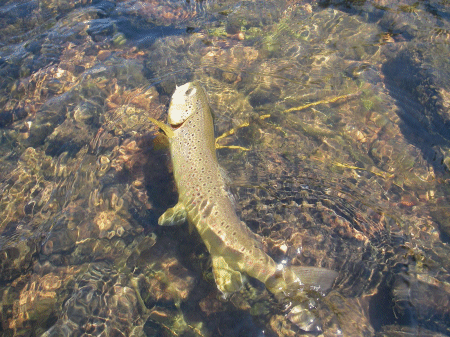 She started catching
the smallish local browns fairly quickly. Eventually I wised up, changed
the "sinker" to another smaller PMD emerger and also began enjoying
some success.
She started catching
the smallish local browns fairly quickly. Eventually I wised up, changed
the "sinker" to another smaller PMD emerger and also began enjoying
some success.
In fact, by a narrow braid by the bank I lucked into a lanky sixteen incher that took the surface fly beneath some willows by the bank.
We worked our way upstream for another quarter mile or so and had lots more results on both floating and trailing flies.
Before we walked back to the car for lunch I'd guess we'd had strikes from several dozen fish, though neither of us either played or released more than a couple dozen of those same fish. She also released a rare cutthroat - a strain I've never seen on this part of the Colorado.
With tummies full we drove back towards Parshall, up to Williams Fork Reservoir, parked and did a mile or so wade on the inlet stream to that lake. Again, the fishing turned out to be wonderful.
 Flows into the lake
this time of year are very light - maybe 15 c.f.s at most.
Flows into the lake
this time of year are very light - maybe 15 c.f.s at most.
Trout here - all rainbows - are concentrated under overhanging willow branches and roots and in the deeper pools and runs.
But they are here. Every place that should have held a fish did so.
Nothing was really large, but both of us played bows into the 12-14 inch range. Again, because of the lack of overhead protection from predators, the fish tended to stay at the deepest part of pools and where vegetation gave them decent cover.
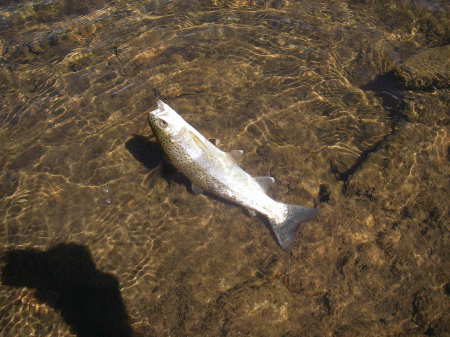
A trailing weighted SWS (see flyty.htm) was by far the most productive pattern.
It turned out to be a terrific outing - assuming of course that one enjoys smaller browns and rainbows - which we do.
More in September after the Wyoming/Montana trip.
Home, Main Fishing Page, , Eagle River Access, Local Ten Commandments, Successful Fly Patterns